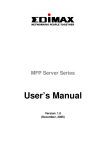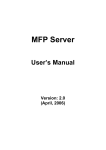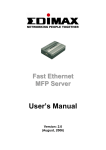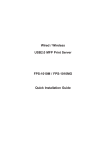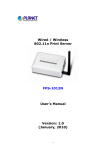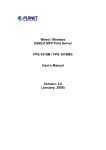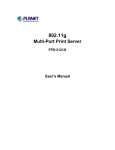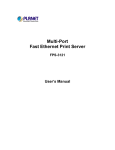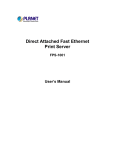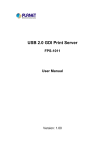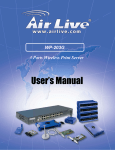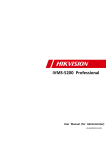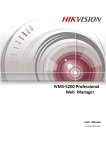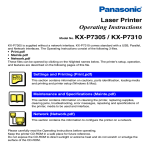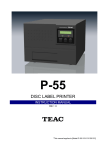Download MFP Print Server
Transcript
802.11g USB MFP Print Server FPS-1010MG User’s Manual Version: 1.0 (February, 2006) Copyright Copyright© 2006 by PLANET Technology Corp. All rights reserved. No part of this publication may be reproduced, transmitted, transcribed, stored in a retrieval system, or translated into any language or computer language, in any form or by any means, electronic, mechanical, magnetic, optical, chemical, manual or otherwise, without the prior written permission of PLANET. PLANET makes no representations or warranties, either expressed or implied, with respect to the contents hereof and specifically disclaims any warranties, merchantability or fitness for any particular purpose. Any software described in this manual is sold or licensed "as is". Should the programs prove defective following their purchase, the buyer (and not this company, its distributor, or its dealer) assumes the entire cost of all necessary servicing, repair, and any incidental or consequential damages resulting from any defect in the software. Further, this company reserves the right to revise this publication and to make changes from time to time in the contents hereof without obligation to notify any person of such revision or changes. All brand and product names mentioned in this manual are trademarks and/or registered trademarks of their respective holders. Federal Communication Commission Interference Statement This equipment has been tested and found to comply with the limits for a Class B digital device, pursuant to Part 15 of FCC Rules. These limits are designed to provide reasonable protection against harmful interference in a residential installation. This equipment generates, uses, and can radiate radio frequency energy and, if not installed and used in accordance with the instructions, may cause harmful interference to radio communications. However, there is no guarantee that interference will not occur in a particular installation. If this equipment does cause harmful interference to radio or television reception, which can be determined by turning the equipment off and on, the user is encouraged to try to correct the interference by one or more of the following measures: 1. Reorient or relocate the receiving antenna. 2. Increase the separation between the equipment and receiver. 3. Connect the equipment into an outlet on a circuit different from that to which the receiver is connected. 4. Consult the dealer or an experienced radio technician for help. FCC Caution: To assure continued compliance.(example-use only shielded interface cables when connecting to computer or peripheral devices). Any changes or modifications not expressly approved by the party responsible for compliance could void the user’s authority to operate the equipment. This device complies with Part 15 of the FCC Rules. Operation is subject to the Following two conditions: (1) This device may not cause harmful interference, and (2) this Device must accept any interference received, including interference that may cause undesired operation. Federal Communication Commission (FCC) Radiation Exposure Statement This equipment complies with FCC radiation exposure set forth for an uncontrolled environment. In order to avoid the possibility of exceeding the FCC radio frequency exposure limits, human proximity to the antenna shall not be less than 20 cm(8 inches) during normal operation. R&TTE Compliance Statement This equipment complies with all the requirements of DIRECTIVE 1999/5/CE OF THE EUROPEAN PARLIAMENT AND THE COUNCIL OF 9 March 1999 on radio equipment and telecommunication terminal Equipment and the mutual recognition of their conformity (R&TTE) The R&TTE Directive repeals and replaces in the directive 98/13/EEC (Telecommunications Terminal Equipment and Satellite Earth Station Equipment) As of April 8,2000. Safety This equipment is designed with the utmost care for the safety of those who install and use it. However, special attention must be paid to the dangers of electric shock and static electricity when working with electrical equipment. All guidelines of this and of the computer manufacture must therefore be allowed at all times to ensure the safe use of the equipment. WEEE regulation To avoid the potential effects on the environment and human health as a result of the presence of hazardous substances in electrical and electronic equipment, end users of electrical and electronic equipment should understand the meaning of the crossed-out wheeled bin symbol. Do not dispose of WEEE as unsorted municipal waste and have to collect such WEEE separately. Revision User’s Manual for PLANET 802.11g USB MFP Print Server Model: FPS-1010MG Rev: 1.0 (February, 2006) Part No. EM-FPS1010MG Contents 1. Introduction ............................................................................................................................. 1 2. Product Package..................................................................................................................... 1 3. MFP Server Installation in Windows 2000/XP ........................................................................ 2 4. 5. 6. 3.1 Hardware Installation ............................................................................................. 2 3.2 Software Installation Procedure............................................................................. 2 3.3 MFP Server Utilities ............................................................................................... 8 3.4 Install the MFP Drivers/Utilities.............................................................................. 8 Using the MFP ...................................................................................................................... 13 4.1 Share Printer and Fax ......................................................................................... 13 4.2 Share Scanner..................................................................................................... 14 4.3 Share Card Reader ............................................................................................. 15 MFP Server Control Manager ............................................................................................... 16 5.1 MFP Server List ................................................................................................... 16 5.2 My Favorite .......................................................................................................... 17 5.3 Auto Connect List ................................................................................................ 18 5.4 Quick Setup ......................................................................................................... 21 5.5 Option Settings .................................................................................................... 22 General Setting ............................................................................................22 5.5.2 Installed MFP List ........................................................................................23 5.5.3 Search for MFP Server ................................................................................24 Server Configuration ............................................................................................................. 25 6.1 Introduction .......................................................................................................... 25 6.2 Status................................................................................................................... 26 6.3 Setup ................................................................................................................... 27 6.4 7. 5.5.1 6.3.1 General Configuration..................................................................................28 6.3.2 TCP/IP Configuration ...................................................................................29 6.3.3 System Configuration...................................................................................30 6.3.4 Wireless Configuration.................................................................................30 6.3.5 MFP Server Management............................................................................42 Report .................................................................................................................. 43 Web Management................................................................................................................. 44 7.1 Introduction .......................................................................................................... 44 7.2 Login .................................................................................................................... 44 7.3 Device Setup ....................................................................................................... 45 7.3.1 System .........................................................................................................45 7.3.2 Printer ..........................................................................................................45 7.3.3 TCP/IP .........................................................................................................46 7.4 Setup Wizard ....................................................................................................... 46 7.4.1 System .........................................................................................................46 7.4.2 Wireless .......................................................................................................48 7.4.3 TCP/IP .........................................................................................................52 7.4.4 Save Settings...............................................................................................53 7.5 System Tools ....................................................................................................... 53 7.5.1 Load Default.................................................................................................53 7.5.2 Upgrade Firmware from Browser.................................................................54 8. LPR Printing .......................................................................................................................... 55 9. IPP Printing ........................................................................................................................... 62 10. 11. 9.1 Introduction .......................................................................................................... 62 9.2 System Setup ...................................................................................................... 62 9.2.1 MFP Server Side..........................................................................................62 9.2.2 Client Side....................................................................................................62 MFP Server Installation in Windows 98SE/Me/NT ............................................................... 66 10.1 Software Installation Procedure........................................................................... 66 10.2 Server Utilities...................................................................................................... 71 10.3 Network Port Setup ............................................................................................. 71 10.4 Add Printer........................................................................................................... 72 UNIX System Network .......................................................................................................... 76 11.1 Introduction .......................................................................................................... 76 11.2 Enable MFP Server’s TCP/IP Support ................................................................ 76 11.3 Setup MFP Server’s IP Address .......................................................................... 76 11.3.1 DHCP...........................................................................................................77 11.3.2 BOOTP ........................................................................................................77 11.4 Verify MFP Server’s IP Address .......................................................................... 78 11.5 Configure Remote LPD Printing on the Host....................................................... 78 12. MFP Server Installation in MAC OS ..................................................................................... 81 13. Troubleshooting .................................................................................................................... 85 Appendix A: MFP Server Compatibility List................................................................................... 87 Appendix B: Specification.............................................................................................................. 89 1. Introduction Thank you for purchasing and using our MFP print server. This FPS-1010MG allows your Multi-function printer (called for short: MFP) or printer to become a shared device on the network. Unlike many print servers, it can communicate with MFP and printer as if it is connected directly to your computer. Because of the features, all users can share print, scan, fax and card reader functions through the network. Furthermore, the FPS-1010MG can build the bi-directional communication with MFPs and Printers so that it can help to monitor important information such as ink levels and paper levels. The FPS-1010MG supports print, scan, fax and card reader sharing functions in Windows 2000 SP4 above and XP SP1 above. It also supports Windows XP scanning utility and MFP vendors’ scanning utilities. When you want to scan in the Windows XP, you can choose one of the utilities. Not only be a MFP print server, this FPS-1010MG can also be a traditional print server. It supports TCP/IP network protocol and LPR and IPP printing protocols. It can share print function in the various common network operating systems including Windows 98SE/Me/NT/2000/XP/2003, Unix, Linux and MAC OS 9.x above. And it is GDI interface supported. So it can co-work with the GDI printer. This device provides a built-in high-performance wireless interface at the transfer rate up to 54Mbps for users to enjoy the convenience of wireless printing. The Print Server supports both "Ad-Hoc mode" (point-to-point wireless networks) and "Infrastructure mode" (using your existing Wireless access point). Users can make choice of the most appropriate mode for their own wireless network. Supports 64/128-bit WEP and WPA-PSK for securing wireless network connections. Since the FPS-1010MG is compliant with 802.11b/g, you can use FPS-1010MG with your existing 802.11b network as well. The FPS-1010MG is the best solution for users to share MFP or printer conveniently and easily. It offers the most flexibility and manageability for MFP or printer on your Local Area Network at an extremely low cost and with an absolute minimum setup and maintenance required. 2. Product Package This package contains the following components: One FPS-1010MG One Power Adapter One Quick Installation Guide One CD-ROM (Including all the software utilities, drivers and User’s Manual) One Dipole Antenna 1 3. MFP Server Installation in Windows 2000/XP 3.1 Hardware Installation 1. Unpack the FPS-1010MG package and verify the items listed in the previous section are provided. 2. Use USB cable to connect FPS-1010MG to the MFP or printer that you want to share to your network. 3. Use a RJ-45 cable to connect the FPS-1010MG to your LAN or WAN. 4. Connect dipole antenna to FPS-1010MG antenna connector. 5. Connect the bundled power adapter to FPS-1010MG. The MFP Server will perform the Power-On-Self-Test (POST) after power on. Please wait for 20 seconds. Note: 1. Please use the power adapter which bundled with MFP Server. DO NOT use any other power adapter from other sources. That may cause your FPS-1010MG damage. 2. To prevent the compatibility problem between FPS-1010MG and a few MFP or printer, it is recommended that you power on the FPS-1010MG before the MFP or printer. 3.2 Software Installation Procedure Before installation begin, please check your computer’s operating system. The operation below is the installation of Windows 2000 SP4 and Windows XP SP1 or above. For the installation procedures in Windows 98SE/Me/NT and other operating systems, please refer to the other sections. Note: Some MFP printers will ask the user connect MFP to the PC directly and install the printer driver, before MFP Server installation. That may cause the MFP Server installation adds one more MFP (printer/scanner/fax/card reader) to your PC. You can delete the devices which the MFP driver installed after MFP Server installation, or you can keep those devices exist in your PC. 1. Insert User’s Manual and utility CD into the CD-ROM drive to initiate the autorun program. Once completed a menu screen will appear. 2. Click on “MFP Server Utility” hyper link to initiate the installation. Or you can click the “Start” button and choose “Run”. (Suppose “E” is your CD-ROM drive). When the dialog box appears, enter “E:\Utility\Setup.exe” and press enter key. You will see the dialog box as below. Please click “Next” to continue. 3. The “MFP Server Utilities - InstallShiled Wizard” is displayed, click "Next". 2 4. Click “Next” to install the MFP Server utilities in the default folder or click “Change” to specify the destination folder where you would like to install the MFP Server utilities. 5. The system starts installing the MFP Server Utilities. 3 6. The “MFP Server Configuration” screen is displayed. If you want to configure the MFP Server, please select “Yes, I want to configure the MFP Server now.” and click “”Next”. Then refer to the following steps to configure your MFP server. Or you can select “No, I will configure the MFP Server later” and click “Next” to complete the installation. 7. The MFP Server List will auto search the MFP Servers in the network. Select the MFP Server you wan to setup and click “Next” to continue. 4 8. Enter the “User Name” and “Password” of the MFP Server you have selected to login the MFP Server. The default “User Name” and “Password” is “admin”. Click “OK”. 9. Set the “Alias Name” and the “MFP Server Description” to the MFP Server here. Click “Next”. Note: You can define the location or other information of the MFP Server for easy to find the MFP by filling “MFP Server Description”. 5 10. 11. You can keep the MFP Server work with the obtain IP address or select “Assign MFP Server IP Address” and enter the IP address to MFP Server directly. Please click “Next”. The configurations are finished. Please click “Finish” to apply new settings. 6 12. Click “Finish” to complete the installation. 7 3.3 MFP Server Utilities After the installation is completed, there will be three utilities in MFP Server’s Program folder. MFP Server Control Manager – Allows you to manage the connection between the MFP and your computer for sharing MFP function. Server Configuration – Allows you to configure the MFP Server’s IP Address, network protocols and other advanced features. It also allows you to manage the MFP Server. Uninstall – Assistant for removing all installed MFP Server software programs. About Version – This file shows the installed driver and utilities version. 3.4 Install the MFP Drivers/Utilities When the installation is completed, the “MFP Server Control Manager” will pop up. It will automatically find the MFP Servers and the connected MFP and show it in the “MFP Server List”. To start installing the MFP Drivers/Utilities, please follow the steps below. 8 1. Select the MFP which you want to install in the “MFP Sever List” and click “Install Wizard”. 2. The following message is displayed to warn you that you have to follow the installation instructions in the manual of the MFP. If the MFP is requiring you to connect the MFP to your computer directly, please click “Connect”. Note: Some MFP requires users to install the drivers/utilities before connecting the MFP to your computer, please make sure you have followed the instructions of MFP. When the MFP requires checking if you have connected the USB cable to MFP and your computer, please click “Connect” to create the connection. Please refer to the below 9 illustration of “HP OfficeJet 5610” as an example. 3. If the MFP has required you to plug the USB cable between the MFP and your computer, please click “Yes”. 4. Before creating the connection, you have to install two kinds of drivers: the drivers for MFP Server and the drivers for MFP. Please click “Next” to start the installation. 5. When you are installing the MFP Server Drivers, the following message will be displayed to notify you. When the MFP Server drivers are all installed, the message will be disappeared automatically. 10 6. Select “Install the software automatically (Recommended)” to auto install the “MFP Server Enhanced Controller” driver, then click “Next”. 7. The driver will be installed automatically. Click “Finish” to complete this driver installation. 11 8. The following message is displayed to remind you that you are now installing the MFP Drivers. When you are sure that the MFP has been connected to MFP Server and the MFP driver CD is insert to your CD-ROM completely, please click “Finish”. 9. Windows will start install the MFP. Please refer to your MFP manual and follow the steps to install MFP driver and utility. 12 4. Using the MFP After you have followed the install wizard to finish the MFP installation, the MFP is now connected to your computer. You can start sharing print, scan, fax and card reader functions provided on the MFP. Note: If you have finished using the MFP, please click “Disconnect” to release the MFP from your PC. When there is a user using or connecting MFP, the other users can’t use the MFP until the MFP is released. You may refer to MFP Server manual to setup the disconnect time to make the users auto-disconnect when the MFP is no operation over the time. 4.1 Share Printer and Fax The MFP will be added to “Printers and Faxes” in the Windows after the MFP is installed. When you have connected to the MFP by clicking “Connect” in the “MFP Server Control Manager”, the MFP Server will auto create the connection between the MFP and your computer and then you can print a document just follows the same steps as usual. 13 4.2 Share Scanner Most of the MFP provides scan utility for users. You can scan pictures or documents through the utility. In Windows XP, user can also scan from Windows XP scanning utility. An example: HP 5600 Series Utilities 14 Windows XP Scanning Utility 4.3 Share Card Reader If the MFP supports card reader function, you can read the files from the plugged card reader through the MFP Server. 15 5. 5.1 MFP Server Control Manager MFP Server List The “MFP Server Control Manager” can automatically find the MFP server in the network and show it in the MFP Server List. Users can select a MFP and click “Connect” to connect the MFP just like you have directly connected the MFP to your computer through USB cable. It also displays the information of the connection status. MFP Server List MFP Server List The “MFP Server List” will list all the MFP Servers within the network. You can find the information of the MFP Servers including “MFP Server Name”, “MAC ID”, “IP Address” and the device that is connected to the MFP Server. MFP Information When you are clicking on the “MFP Server” in the “MFP Server List”, you will see the “MFP Server Description” and the “Idle Timeout” setting for the MFP Server. MFP Server Description – It is a description that can help users to identify where or what the MFP Server is. When you are clicking on the “MFP” in the “MFP Server List”, you will see the information including “Status”, “Computer Name” and “Contact Information”. 16 Status – It displays the status of the MFP including Connected, Idle and Busy. When the status is “Connected”, it indicates that you are connecting the MFP. When the status is “Idle”, it indicates that the MFP is not being used. When the status is “Busy”, it indicates that other user is using the MFP to scan, print, or etc. Computer Name – It display the computer name of the user who is connecting to the MFP. Contact Information – When the current user has set his “Contact Information”, you can see it here. You can contact with the current user for asking to disconnect the MFP. Refresh Refresh the “MFP Server List” immediately. Connect Let the MFP be connected to your computer. Disconnect Disconnect the selected MFP. Add to My Favorite Add the MFP Servers that you frequently use to “My Favorite List”. Install Wizard When you install the MFP at the first time, click “Install Wizard” will help you to go through all the installation steps and complete the installation. 5.2 My Favorite You can add the frequently use MFP Servers to “My Favorite” list. The MFP Server in the list will be added to the quick link list when you right click the MFP Server icon in the system tray. Please refer to Section 5.4 to know more about the quick setup functions. 17 My Favorite My Favorite List The “My Favorite List” will list your favorite MFP Servers. You can find the information of the MFP Servers including “MFP Server Name”, “MAC ID”, “IP Address” and the device that is connected to the MFP Server. MFP Server/MFP The information listed here are the same as MFP Server List. Please Information refer to Section 5.1. Refresh Refresh the “MFP Server List” immediately. Connect Let the MFP be connected to your computer. Disconnect Disconnect the selected MFP. Delete Delete the selected MFP Server from the “My Favorite List”. 5.3 Auto Connect List To let the system occupy the MFP server automatically when you want to print a document just like the behavior of using traditional print server, you can add the MFP into your Auto Connect List. The system will send the printing jobs to the MFP when the MFP Server is idle and not being connected. Note: If you have sent a printing job to the MFP while the MFP is busy or connected, you may be prompt that the device is not found or not connected. The MFP may queue your printing job in your computer spooler. The MFP Server will then print the job after the MFP is idle or 18 disconnected. To add the MFP to the Auto Connect List, please follow the steps below. 1. Click “Add” from the “Auto Connect List”. 2. The MFP Servers within the network will be displayed in the following screen. Select the MFP Server you would like to add to the list. 19 3. Select the MFP that is connected to the selected MFP Server. Click “Ok”. 4. The setup is finished. 20 5.4 Quick Setup Right click on the MFP Server icon in the system tray you can see the MFP servers you have designated to “My Favorite List”. You can directly connect or disconnect the MFP and check the MFP information from the here easily. Quick Setup Status The current status of the MFP will be displayed here. “Connected” indicates that you are connecting to the MFP. “Busy” indicates the MFP is being used. “Idle” indicates that the MFP is free to use by any users. Connect If the MFP is free to use, the “Connect” will be available to click for occupying the MFP. Or it will be grayed. Disconnect Disconnect the selected MFP. The “Disconnect” will be available only for the user who is using this MFP. Information To check more information about the MFP Server and the MFP, please click this button. The information will be listed as the illustration below. 21 Open Control Manager When press this button. The MFP Server Control Manager will be appear. 5.5 Option Settings 5.5.1 General Setting General Setting Start Control Manager on Execute the “MFP Server Control Manager” when Windows Windows startup starts every time. By default, it is enabled. Minimized when start Control Minimized the “MFP Server Control Manager” to an icon in the Manager system tray when you start the “MFP Server Control 22 Manager”. By default, it is disabled. Refresh status every xx Setup the refresh interval for device status update. By default, seconds. (5~300) it is disabled. Auto release when idle time is To avoid users occupy the MFP overtime; users can setup idle over xx seconds. (5-300) timeout. It is used to disconnect the current connection after the MFP is idle for a specified period of time. By default, it is never timeout. When you are clicking on the “MFP” in the “MFP Server List”, you will see the information including “Status”, “Computer Name” and “Contact Information”. Your Contract Information Enter your contact information here. When you connect to the MFP, your contact information will be displayed in the right side of the program for other users to contact you. 5.5.2 Installed MFP List The MFPs that have been installed will be displayed in the list. If you have removed the MFP from your computer, please delete the MFP from the list. The “MFP Server Control Manger” will guide you to install the MFP when you want to install the same MFP next time. 23 5.5.3 Search for MFP Server If there is an MFP Server is not in the network as your computer, you can enter the IP Address of the MFP Server to do the remote search. The MFP Server in the “Remote MFP Server List” will be added to the “MFP Server List” for you to configure. Note: If the remote MFP Server you have searched is behind NAT Router, the MFP Server may not operate normally. 24 6. Server Configuration 6.1 Introduction This chapter introduces MFP Server’s system configuration utility in Windows environment. This utility provides the most complete management and configuration functions on the MFP Server side. This utility only provides configuration functions for MFP Server itself; it does not include configuration functions for client side or other file server in the network environment. The Configuration Utility provides the following configuration and management functions: Status: Display MFP Server Network Status. Setup: Configure the MFP Server detail settings. General Configuration: Configure general settings about the MFP Server such as Server Name, Password, etc. TCP/IP Configuration: IP Address and DHCP Server Configuration. System Configuration: MFP Server Network Ability Setting and Firmware Upgrade. Wireless Configuration: Configure wireless settings and operating mode. MFP Server Management: For administrator to manage the MFP Server. Administrator can force disconnect the current connection and setup idle time out of the MFP Server. Report: List the some information of all available MFP Servers on the Network. Refresh: Refresh the MFP Server’s status by pressing the “Refresh” button. Reboot: Restart the MFP Server by pressing the “Reboot” button. Search MFP Server: Search all available MFP Servers on the Network. 25 6.2 Status Click “Status” icon on the tool bar, the status of the currently selected MFP Server will be showed on the right side of the window. The information of the MFP Server displayed are including MAC ID, Model Type, Firmware Version, status of each server port, IP address, subnet mask, default gateway and supported printing protocols…etc. 26 6.3 Setup Click “Setup” icon on the tool bar, the setup items of the current selected MFP Server will be showed on the right side of the window. Double click one of the icons to set up the selected MFP Server. A screen will pop up to verify “User Name” and “Password” of the MFP Server. The default values are: User Name: admin, Password: admin. Note: When you have finished the settings, please click “ let the settings take effect. 27 ” to restart the MFP Server to 6.3.1 General Configuration Double Click “General” icon and the General configuration window will pop-up. You can see basic MFP Server information in this page. You also can configure the “Server Name”, “User Name” and “Password” here. Server Name, the name of the MFP Server. You can use this name to identify the MFP Server when you are searching for the MFP Server by the “Server Manger” utility. User Name / Password is used to authenticate the administrator to login the MFP Server for configuring it from the “Server Manger” utility or the Web Management tool. 28 6.3.2 TCP/IP Configuration Double Click “TCP/IP” icon and the TCP/IP configuration window will pop-up. You can configure the MFP Server to automatically get IP from DHCP server or manually specify static IP. When there is a DHCP Server in your network, you may select ‘Auto IP” of this dialog box to let your MFP Server to obtain an IP address automatically. Or select the “Static IP” to enter the “IP Address”, “Subnet Mask” and “Gateway” for this MFP Server. 29 6.3.3 System Configuration Double Click “System” icon and the System configuration window will pop-up. In the System configuration page, you can see all available printing methods, firmware upgrade and load factory default function. Upgrade Firmware: You can use this “Upgrade Firmware” tool to update the newest firmware of the MFP Server. Click “ ” button and locate the correct firmware in your PC. After find out the firmware, please click the “Upgrade” button to update firmware. Note: Before you upgrade the firmware, please make sure that the IP Address settings of the MFP Server are in the same network as your computer. Load Default: If you want to reset the MFP Server to factory default settings, please click “Load Default”. After load default, please press “ ” to reboot your MFP Server to make the new configuration effect. 6.3.4 Wireless Configuration Due to wireless interface is “Auto” in default. If you want to use the print server through wireless interface, please set up the MFP server through Ethernet firstly. After configure the wireless LAN settings, unplug the Ethernet cable from the MFP server, then you can start to use the MFP server via wireless interface. If the wireless configuration does not work, please 30 plug the Ethernet cable again and configure the print server through Ethernet until the wireless LAN settings are correct. When the wireless interface work correctly, and you don’t need to work with Ethernet interface, you may change the Wireless Function to “Enable” to disable Ethernet interface. You may select either Infrastructure Mode or Ad-hoc Mode for this printserver to join your wireless network. 6.3.4.1 Infrastructure Mode If you are select “Infrastructure Mode” and click “Next” in section 7.11, you will see the dialog box below. You can select first option to scan your wireless network to search the Access Point that you want to connected. Or you can select the second option and enter the SSID you had known into the field. Please choose one of them and click “Next”. 31 2. When you are select first option to continue, you will see this screen for scan the wireless network. Please select the wireless device that you want to connect and click “Next”. If you don’t have see the wireless device that you would like to connected, please click “Scan” to search again. 32 3. This print server supports WEP and WPA-PSK security mode. If you want to use WEP encryption to protect your wireless network, you have to select “WEP(ASCII)” or “WEP(HEX)”. If you want to use WPA-PSK, you have to select “WPA-shared key”. The wireless security setting should be the same with other wireless devices in the same network. WEP Security Mode: 33 You can select “64 bit” or “128 bit” length and “Hexdecimal” or “ASCII” format for the encryption key. Longer key length can provide stronger security but worth communication performance. Enter four key values by following the rules below and select one key as the default key. y PassPhrase – A passphrase simplifies the WEP encryption process by automatically generating the WEP encryption keys for the print server. This setting is only valid when the security mode is in “WEP(HEX)”. y Key 1 to Key 4 – If the key length is 64-bit, enter 10-digit Hex values or 5-digit ASCII values as the encryption keys. For example: “0123456aef“ or “Guest“. If the key length is 128-bit, enter 26-digit Hex values or 13-digit ASCII values as the encryption keys. For example: “01234567890123456789abcdef“ or “administrator“. 34 WPA-shared key Security Mode: Wh en “WPA-sh ared ke y” , a lso n a med “W PA- PSK” r eq uir es us ers to se lec t the a d vanc ed e ncr yp tion me thods , i.e . T KIP a nd en te r a se t o f sh ared k e y. y y WPA Algorithms - TKIP (Temporal Key Integrity Protocol) changes the temporal key every 10,000 packets. This insures much greater security than the standard WEP security. Shared Key - Enter 8 to 63 digits of ASCII format to be the key for the authentication within the network. When you finish configuring the wireless security, click “Next” to go to next step. 35 4. You can select to let the print server automatically obtain IP settings from DHCP Server or manually assign the IP settings. If you manually assign the IP settings, you have to enter IP address, subnet mask and default gateway address. When you finish configuring the IP settings, click “Next” to confirm the IP Address configuration. 5. Please click “Save” to save the wireless configuration. 36 6. You will see this dialog box to prompt you the settings will be saved. Please press “Yes” to save. 6.3.4.2 1. Ad-Hoc Mode You can let the print server automatically associate with other wireless station or manually assign the SSID of your wireless network. You can let the MFP server automatically select the channel that is the same with the peer or manually assign a channel. 2. If you are select the first option to continue, you will see this screen for scan the wireless network. Please select the wireless device that you want to connect and click “Next”. If you don’t have see the wireless device that you would like to connected, please click “Scan” to search again. 37 3. This print server supports WEP and WPA-PSK security mode. If you want to use WEP encryption to protect your wireless network, you have to select “WEP(ASCII)” or “WEP(HEX)”. If you want to use WPA-PSK, you have to select “WPA-shared key”. The wireless security setting should be the same with other wireless devices in the same network. 38 WEP Security Mode: You can select “64 bit” or “128 bit” length and “Hexdecimal” or “ASCII” format for the encryption key. Longer key length can provide stronger security but worth communication performance. 39 Enter four key values by following the rules below and select one key as the default key. y PassPhrase – A passphrase simplifies the WEP encryption process by automatically generating the WEP encryption keys for the print server. This setting is only valid when the security mode is in “WEP(HEX)”. y Key 1 to Key 4 – If the key length is 64-bit, enter 10-digit Hex values or 5-digit ASCII values as the encryption keys. For example: “0123456aef“ or “Guest“. If the key length is 128-bit, enter 26-digit Hex values or 13-digit ASCII values as the encryption keys. For example: “01234567890123456789abcdef“ or “administrator“. WPA-shared key Security Mode: Wh en “WPA-sh ared ke y” , a lso n a med “W PA- PSK” r eq uir es us ers to se lec t the a d vanc ed e ncr yp tion me thods , i.e . T KIP a nd en te r a se t o f sh ared k e y. y y WPA Algorithms - TKIP (Temporal Key Integrity Protocol) changes the temporal key every 10,000 packets. This insures much greater security than the standard WEP security. Shared Key - Enter 8 to 63 digits of ASCII format to be the key for the authentication within the network. When you finish configuring the wireless security, click “Next” to go to next step. 40 4. You can select to let the print server automatically obtain IP settings from DHCP Server or manually assign the IP settings. If you manually assign the IP settings, you have to enter IP address, subnet mask and default gateway address. When you finish configuring the IP settings, click “Next” to confirm the IP Address configuration. 5. Please click “Save” to save the wireless configuration. 41 6.3.5 MFP Server Management Double Click “MFP Server Management” icon and the MFP Server configuration window will pop-up. You are able to manage the MFP Server as below. Force Release: Select the port number and then click “Force Release” will help to you disconnect the current connection between the user and the connected device. It is very useful when a user forgets to disconnect the MFP, administrator can force to disconnect the connection and let the MFP be free to use. MFP Server Description: Enter 15 digits description of the MFP Server such as location or other information to help user to find the MFP Server easily. Note: After all users have installed the MFP successfully. It is recommended that enable the “Auto Release when idle timeout” setting in “MFP Server Control Manager” => “Option”, so that the MFP resource will not be occupied easily by only one user. 42 6.4 Report Click “Report” icon on the tool bar, the Report window will pop up. The report lists basic information of all available MFP Servers on the network. The information includes Device Name, MAC ID, Model Type and Firmware Version of MFP Server. 43 7. 7.1 Web Management Introduction MFP Server can be configured and managed by Web Browser. Through Local Area Network, or even Internet, administrator can easily configure and manage MFP Server’s various main functions in browsers. Simply enter MFP Server’s IP address into your browser’s address field to manage a MFP Server by MFP Server’s built-in Web Server. The default IP Address, User Name and Password settings of the MFP Server are as follows. IP Address: 192.168.0.1 User Name: admin Password: admin 7.2 Login You may use any Web Browser to review the status or configure the settings of the MFP Server. After entering the IP address of the MFP Server, a login dialog box will display. You have to enter correct “User Name” and “Password” before going to the Web Management pages. 44 7.3 7.3.1 Device Setup System System Information includes “Device Name”, “MFP Server Name”, “Model Type”, “Firmware Version”, “MAC Address”, “Wireless Status” and the protocols enabled status, etc. 7.3.2 Printer This page will show the information of MFP or printer that connected to the MFP Server port. 45 7.3.3 TCP/IP This page lists all TCP/IP settings of the MFP Server including “IP Address”, “Subnet Mask” and “Gateway”. It also can tell the DHCP server is “On” or “Off”. 7.4 7.4.1 Setup Wizard System You can change the MFP Server name and password of the MFP Server from here. 46 MFP Server Name, the name of the MFP Server. You can use this name to identify the MFP Server when you are searching for the MFP Server by the “Server Manager” utilities. Password, enter the password you want to change to the MFP Server. The password can be up to 7-digit alphanumeric format. The default password is “admin”. Re-type Password, enter the same password for the MFP Server again. 7.4.1.1 Advanced Settings Some advanced feature of the MFP Server can be set here. TCP/IP Printing: This MFP Server supports TCP/IP network protocol and LPR/IPP printing protocols. By default these protocols are enabled. 47 7.4.2 Wireless If you want to use the print server through wireless LAN, please set up the MFP server through Ethernet first and make sure your wireless LAN settings are correct. After setting the wireless LAN, unplug the Ethernet cable and restart the MFP server, then you can start to use the MFP server through wireless LAN. If the wireless configuration does not work, please plug the Ethernet cable again, restart the print server and configure the MFP server through Ethernet until the wireless LAN settings are correct. Function is for user to disable, enable or let the MFP server auto select to connect to the wired or wireless network. If “Disable” is selected, the print server can only connect to the network through wired Ethernet. If “Enable” is selected, the print server can only connect to the network through Wireless LAN. If “Auto” is selected, the print server can automatically decide to enable or disable the wireless function. The MFP server only can work in ether Ethernet or wireless LAN mode. It cannot work in both Ethernet and wireless LAN mode at the same time. Mode is the operation mode of wireless station. You can choose ether “Ad Hoc” or “Infrastructure” mode. If you do not have any access point and want to use peer-to-peer connection, you have to choose “Ad Hoc” mode. If you have an access point as the wireless LAN infrastructure, you have to choose “Infrastructure” mode. ESSID is the unique name identified by in a wireless LAN. The ID prevents the unintentional merging of two co-located WLANs. Please make sure that the ESSID of all 48 stations and access points in the same WLAN network are the same. Channel Number is the channel number of your wireless LAN. Please make sure that the channel number of all stations and access points in the same WLAN network are the same. 7.4.2.1 Site Survey You can use this “Site Survey” function to search for available access points in you location. In the list is the information of all available access points or wireless stations, includes SSID, BSSID, Channel, Type, Encryption and Signal Strength. You can select one wireless device in the list for this print server to associate with or you have to use General Setting to manually setup the wireless parameters. There is “WLAN Function” setting for you to setup Auto/Disable/Enable wireless function of the print server here. Please refer to section 7.4.2 to know more about the setting. 49 7.4.2.2 Encryption WEP Security Mode: y Key Length - You can choose “64-bit” to use WEP with 64-bit key length encryption or choose “128-bit” to use WEP with 128-bit key length encryption. The longer key length can provide better security but worse transmission throughput. 50 y Key Format - You may select to use ASCII Characters (alphanumeric format) or Hexadecimal digits (in the "A-F", "a-f" and "0-9" range) to be the WEP Key. y PassPhrase - A passphrase simplifies the WEP encryption process by automatically generating the WEP encryption keys for the print server. y Default Key - Select one of the four keys to encrypt your data. Only the key you select it in the “Default key” will take effect. y Key 1 - Key 4 - The WEP keys are used to encrypt data transmitted within the wireless network. Fill the text box by following the rules below. 64-bit WEP: input 10-digit Hex values (in the "A-F", "a-f" and "0-9" range) or 5-digit ASCII character as the encryption keys. For example: “0123456aef“ or “Guest“. 128-bit WEP: input 26-digit Hex values (in the "A-F", "a-f" and "0-9" range) or 10-digit ASCII characters as the encryption keys. For example: “01234567890123456789abcdef“ or “administrator“. WPA-PSK Mode: When “WPA-shared key”, also named “WPA-PSK” requires users to select the advanced encryption methods, i.e. TKIP and enter a set of shared key. y WPA Algorithms: TKIP (Temporal Key Integrity Protocol) changes the temporal key 51 every 10,000 packets. This insures much greater security than the standard WEP security. y WPA Key: Enter 8 to 63 digits of ASCII format to be the key for the authentication within the network. When you finish configuring the wireless security, click “Save & Next” to confirm the configuration. 7.4.3 TCP/IP You can configure the MFP Server to automatically get IP from DHCP server or manually specify static IP. The MFP Server also has a built-in DHCP server. You can enable this DHCP server and let it manages IP for you. If you need the MFP Server to automatically get an IP from DHCP server, select “Enable Obtain TCP/IP Settings Automatically (Use DHCP/ BOOTP)”. You also can select “Disable Use the following TCP/IP Settings” to manually assign “IP Address”, “Subnet Mask” and “Gateway” for the MFP Server. 52 7.4.4 Save Settings When you select Save Settings, you will see the dialog box for asking you to make sure you want to save the settings and reboot. Please click “Yes” to save the configuration and reboot. 7.5 System Tools 7.5.1 Load Default You can use this page to restore the MFP Server to factory default settings. Please click “OK” to load the default settings. 53 7.5.2 Upgrade Firmware from Browser You can upgrade new firmware to the MFP Server in this page. Click “Browse” to locate the new firmware in your HDD and then click “OK” to start the upgrade procedure, the firmware will be updated in several minutes. Be aware that if you have started upgrading firmware, please DO NOT turn the MFP Server off. That will make the MFP Server damage due to the firmware doesn’t upload complete. 54 8. LPR Printing LPR Printing (Line Printer Remote technology) allows users to connect to MFPs or printers via TCP/IP for printing sharing. The computer with Windows 98SE/Me/NT/2000/XP/2003 operating system can use the protocol to share printing in the network. MFP Server can support LPR printing by default. If you install the MFP Server in Windows 98SE/Me/NT, the MFP Server provides a tool “Network Port Setup” that help to add the LPR protocol to users’ computer easily. Please refer to Chapter 10. To configure the LPR setting in Windows 2000/XP/2003, please follow the steps below. 1. Click “Start”, choose “Settings” and select “Printers and Faxes”. 2. Click “Add a Printer”. 3. The “Add Printer Wizard” is displayed. Click “Next”. 4. Select “Local Printer attached to this computer” and click “Next”. 55 5. Choose “Create a new port” and “Standard TCP/IP Port”. Click “Next”. 6. Please make sure that the MFP Server and the MFP or Printer have turned on and connected to the network correctly before you continue. Click “Next”. 56 7. Enter the IP Address of the MFP Server in the “Printer Name or IP Address”. Click “Next”. 8. Select “Custom” and click “Settings”. When you have finished the settings at step 9, click “Next” to continue. 57 9. Select “LPR” and enter “lpt1” in the “Queue Name”, click “OK”. By default the queue name of the MFP Server is “lpt1”. 10. Click “Finish”. 58 11. Select a suitable printer manufacturer and the printer model and click “Next”. If your printer is not in the list, click “Have Disk…” to install the driver of the printer. After installation, the printer model will be added to the list. 59 12. Choose to set the print whether as a default printer or not. Click “Next”. 13. Please select the test page will printed after the configuration or not. Please click “Next”. 60 14. You have added the network printer to the PC successfully. The information of the printer is displayed in the windows. Click “Finish”. 61 9. 9.1 IPP Printing Introduction IPP (Internet Printing Protocol) Printing provides a convenient way of remote printing service by TCP/IP. When the MFP Server is work with a legal IP address, it can support IPP printing in Windows 2000/XP/2003 by default. By using the IPP printing, you can share the printer to all the PC’s that can access the MFP Server by IP. You can even share your MFP or printer to Internet users. 9.2 9.2.1 System Setup MFP Server Side It is needless to do any setting on the MFP Server side. Make sure the MFP Server has correct IP settings. If you want to share the printers to Internet users, you have to set a real IP to the MFP Server. You also have to make sure that any gateway, router or firewall does not block IPP protocol if you have these gateway devices installed in your network. 9.2.2 Client Side You only need to perform Window’s standard Add New Printer procedure. 1. Click “Start”, choose “Settings” and select “Printers and Faxes”. 2. Click “Add a Printer”. 3. The “Add Printer Wizard” is displayed. Click “Next”. 62 4. Select “A network printer, or a printer attached to another computer”. Click “Next”. 5. Select “Connect to a printer on the Internet or on a home or office network” and enter the URL of MFP Server. The URL format is “http://IP:631/Port Name”. The IP should be the MFP Server’s IP. The number 631 is IPP standard port number. Port Name is the port name of MFP Server that your printer is connected to. The default port name is “lpt1”. One example of the URL is http://192.168.99.38:631/lpt1. After entering the URL of MFP 63 Server, click “Next”. 6. Select a suitable printer manufacturer and the printer model and click “Next”. If your printer is not in the list, click “Have Disk…” to install the driver of the printer. After installation, the printer model will be added to the list. 7. Choose to set the print whether as a default printer or not. Click “Next”. 64 8. You have added the network printer to the PC successfully. The information of the printer is displayed in the windows. Click “Finish”. 65 10. MFP Server Installation in Windows 98SE/Me/NT This MFP Server supports TCP/IP network protocol and IPP and LPR printing protocols, it can be a print server when you operate it in Windows 98SE/Me/NT/2000/XP/2003, Unix/Linux and MAC OS. The IPP printing protocol can be used in Windows 2000/XP/2003. The LPR printing protocol can be used in Windows 98SE/Me/NT/2000/XP/2003, Unix/Linux and MAC OS. For the LPR and IPP settings in Windows 2000/XP/2003, please refer to Chapter 8 and 9. This chapter will introduce you how to install the MFP Server to be print server in Windows 98SE/Me/NT. Before you start, you should have: One computer with Windows 98SE/Me/NT The TCP/IP network protocol has been installed in the PC 10.1 Software Installation Procedure The following are the installation steps in Windows 98SE. To install MFP Server in Windows Me/NT, the procedures are similar. 1. Insert User’s Manual and utility CD into the CD-ROM drive to initiate the autorun program. Once completed a menu screen will appear. 2. Click on “MFP Server Utility” hyper link to initiate the installation. Or you can click the “Start” button and choose “Run”. (Suppose “E” is your CD-ROM drive). When the dialog box appears, enter “E:\Utility\Setup.exe” and press enter key. You will see the dialog box as below. Please click “Next” to continue. 3. The message is prompted to remind you that the MFP Server will only support print sharing function since the operation system of your computer is Windows 98SE/Me/NT. Click “Ok”. 4. The “MFP Server Utilities - InstallShield Wizard ” will be displayed. Click “Next”. 66 5. Click “Next” to install the MFP Server utilities in the default folder or click “Change” to specify the destination folder where you would like to install the MFP Server utilities. 6. The MFP Server Utilities are being installed. 67 7. The “Configuration” screen is displayed. If you want to configure the MFP Server, please click “”Next” directly. Or you can select “No, I will configure the MFP Server later” and click “Next” to complete the installation. The following steps are for the MFP Server Configuration. 8. The MFP Server List will auto search the MFP Servers in the network. Select the MFP Server you wan to setup and click “Next” to continue. 68 9. Set the “Alias Name” and the MFP Server here. Click on “Next”. 10. Setup the IP address of the MFP Server and click “Next”. 69 11. The settings are finished click “Finish” to apply new settings. 12. Click “Finish” to complete the installation. 70 10.2 Server Utilities After the installation is completed, there will be three utilities in MFP Server’s Program folder. Network Port Setup – Add the network ports of MFP Server within the network to your PC. Server Configuration – Allows you to configure IP Address, network protocols and other advanced functions. Please refer to Chapter 6 for the detail instruction of the configuration. Uninstall – Assistant for removing all installed software. 10.3 Network Port Setup “Network Port Setup” Utility offers a very simple method to add or remove MFP Server’s printer port from the client’s computer. During the MFP Server’s installation procedure, the system will automatically search for all 71 MFP Servers on the network, and add the printer port of the MFP Server you have selected to user’s computer (see below). If you have just installed another new MFP Server in the network, you must run this program first. This program will search for new MFP Servers and allow you to add the new network printer port into your computer conveniently. Perform the standard Add Printer procedure, then you can print directly to the printer through the newly installed MFP Server. Note: Please be aware that Network Port Setup Utility can only detect and configure all MFP Servers within the same network; it cannot search and configure the MFP Servers on other subnets across network segments. 10.4 Add Printer After adding a “Network Port” of the MFP Server to your computer, you can follow the procedure described below to add printer to the Windows. Note that following “Add Printer” steps are running in Windows 98SE, the steps in other Operating Systems are similar. 1. Click “Start”, choose “Settings” and select “Printers”. 2. Click “Add Printer”. 3. The “Add Printer Wizard” is displayed. Click “Next”. 72 4. Select “Local printer” and click “Next”. 5. Select a suitable printer manufacturer and the printer model and click “Next”. If your printer is not in the list, click “Have Disk…” to install the driver of the printer. After installation, the printer model will be added to the list. 73 6. Choose the suitable “Print Server Network Port” and click “Next”. 7. Please enter the new name for the printer or click “Next” to keep the default printer name. 74 8. Choose to print the test page or not. It is recommended to print a test page. Click “Finish”. 9. The drivers of the printer will be installed. After complete the installation, the printer has been added to your computer. 75 11. UNIX System Network 11.1 Introduction The MFP Server is available for TCP/IP printing by Unix LPD (Line Printer Daemon) protocol. The LPD protocol originated with Unix release is based on the BSD version of Unix and supported under most versions of Unix. This chapter explains how to configure the MFP Server for TCP/IP operation, and how to modify configuration files on your Unix system to allow printing to the MFP Server. The configuration examples in this manual follow the syntax for BSD based Unix systems. Please refer to the related system documentation for the correct syntax of your systems. To configure the MFP Server for LPD printing, perform the procedures below: 1. Enable MFP Server’s TCP/IP Support. 2. Set up MFP Server’s IP address. 3. Verify MFP Server’s IP Address. 4. Configure remote LPD printing on the host. 5. Print a test page. In the next sections, we will describe these five procedures step by step. 11.2 Enable MFP Server’s TCP/IP Support The default configuration of the MFP Server is with TCP/IP support enabled. Anyway, you can configure the MFP Server to enable TCP/IP support using the configuration program. 11.3 Setup MFP Server’s IP Address The MFP Server must have a unique IP address in order to be recognized by the network. You can set up the IP address on the various Unix systems using any one of the following methods: 76 1. DHCP (Dynamic Host Configuration Protocol) 2. BOOTP (Bootstrap Protocol) The MFP Server will use the last two methods to obtain its IP address automatically if its IP address is configured as Auto (0.0.0.0). 11.3.1 DHCP There are many Unix systems that support DHCP protocol, and the procedures to configure the DHCP server database are different. Please refer to the manual of Unix for the way to use different DHCP Server. It is highly recommended that the DHCP server should be located on the same network as the MFP Server. 11.3.2 BOOTP If you have the BOOTP daemon, bootpd, running on your UNIX system that is accessible by the MFP Server, you can use the BOOTP protocol to set up the IP address of the MFP Server. We recommend that the BOOTP server should be located on the same subnet as the MFP Server. If you use Network Information Services (NIS) in your system, you may need to rebuild the NIS map with the BOOTP services before doing the following BOOTP configuration. To rebuild the NIS map, please refer to your system documentation. To configure the IP address data for the BOOTP server, you will need to log in the host of BOOTP server as the superuser (root). Perform the following steps to add address entries, 1. Optionally, assign a name corresponding to the MFP Server’s IP address. You can add this address to the /etc/hosts file, by adding a line such as: 203.66.191.12 2. pserver Add an entry to the host’s /etc/bootptab file, similar to the following: hostname:\ 77 :ht=1:\ :ha=MFP_Server_ethernet_address:\ :ip=MFP_Server_ip_address: Lines should be indented with tabs. Where hostname is the device name of a MFP Server, the ht=1 tag specifies the hardware type is Ethernet, the ha= tag specifies the Ethernet address of a MFP Server, which is the Node ID located on the MFP Server. The ha tag must be preceded by the ht tag. The ip= tag should correspond to the IP address you want to assign to the MFP Server. For example, a MFP Server with the following configuration: Node ID: 00304F010101 (this implies Ethernet address is 00304F010101), IP address: 203.66.191.12 The entry for this MFP Server in the /etc/bootptab file should be: MF010101:\ :ht=1:\ :ha=00304F010101:\ :ip=203.66.191.12: 11.4 Verify MFP Server’s IP Address To verify your MFP Server is responding to the newly assigned IP address using a PING command: ping ip-address 11.5 Configure Remote LPD Printing on the Host The procedure you use to configure your Unix host(s) to allow printing to your network remote MFP Server varies between different varieties of Unix. The procedure below can be used for Unix variants that are related to BSD Unix, such as SunOS or Linux. For other versions of 78 Unix, consult your system documentation, keeping in mind that: 1. The MFP Server should be treated as a BSD networked MFP Server host. 2. The host name should be the name (or IP address) that you have assigned to the MFP Server. 3. The printer name (or queue name) on the remote host should be lpt1, lpt2 or lpt3, the name of the printer port on the MFP Server. You will need to perform the tasks below, logged in as the superuser (root). To configure your Unix host for printing, 1. Optionally, assign a name corresponding to the MFP Server’s IP address. You can add this address to the /etc/hosts file, by adding a line such as: 203.66.191.186 2. pserver Create a spool directory for the printer in the same directory where spool directories are normally kept on the machine, such as /var/spool or /var/spool/lpd: mkdir /var/spool/lpd/pserverd chown daemon /var/spool/lpd/pserverd chgrp daemon /var/spool/lpd/pserverd chmod 775 /var/spool/lpd/pserverd 3. Add an entry to the host’s /etc/printcap file, similar to the following: printer-name:\ :lp=:\ :rm=203.66.191.186:\ :rp=lpt1:\ :lf=/var/spool/lpd/pserverd.log:\ :sd=/var/spool/lpd/pserverd:\ :mx#0: Lines should be indented with tabs. More than one printer name can be used, with variants separated by vertical bars (name1|name2). 79 The rm= entry should correspond to the IP address you have assigned to the MFP Server. You can also use a host name if you have assigned one in the /etc/hosts file. The sd= entry should correspond to the spool directory you created in the previous step. The rp= entry should correspond to the port name of the remote printer. The values should be one of lpt1, lpt2 or lpt3 depends on the printer port. The MFP Server should now be available for printing from your Unix host. 80 12. MFP Server Installation in MAC OS LPR Printing (Line Printer Remote technology) allows Macintosh computers to connect to MFPs or printers via TCP/IP. LPR Printing can be set up on any Macintosh with version 9.x above. To enable LPR Printing in Macintosh, please follow the procedures below. 1. In the Desktop, click “System Preferences”. 2. Click “Print & Fax”. 3. From the “Print & Fax” screen, click “Set Up Printers…”. 81 4. Click “Add” to add the new MFP Server through TCP/IP. 5. Enter the “Printer Type”, “Printer Address” and “Queue Name” and select the “Printer Model” to setup the MFP Server. Click “Add” to continue. Printer Type: LPD/LPR Printer Address: Input the IP Address of the MFP Server Queue Name: The queue name of the MFP Server is “lpt1”. Printer Model: Select the MFP or Printer Model that is attached to the MFP Server. 82 6. The MFP Server is installed completely. You can see it in the “Printer List”. 7. You can print a file to check whether the MFP Server is installed successfully. 83 84 13. Troubleshooting 1. This product is not found even after searching by the “MFP Server Control Manager”. Check if the power adapter and the network cable are connected to the MFP Server properly. Check if the LAN or WLAN LED is turned on. Check if the IP Address of the MFP Server is in the network segment as your computer. - If you are not sure the IP Address setting of the MFP Server, please check the TCP/IP setting of the MFP Server from the “Server Manager”. 2. The ways to change the IP Address of the MFP Server. A DHCP Server is installed in the network If a DHCP Server is installed, you can setup to let the MFP Server get IP Address from the DHCP Server automatically. 1. Open “Server Manager” and then select “TCP/IP” setting. 2. Select “Auto IP” and click “Save”. 3. Reboot the MFP Server. Set up the IP Address Manually 1. Open “Server Manager” and then select “TCP/IP” setting. 2. Select “Static IP” and enter the IP Address and Subnet Mask as your computer. Click “Save”. 3. Reboot the MFP Server. Note: Set a static IP Address to MFP Server is recommended since DHCP assignment may dramatically change the IP Address for MFP Server. 85 3. A user always connects the MFP Server. Check the “Idle Timeout” setting of the MFP Server from the right side of “MFP Server Control Manager”. If the status is “Never Timeout”, please contact with your administrator to change the setting. Contact with the current user and ask the user to disconnect the device. If the user forgets to disconnect the device, you can inform the administrator to release the device. 4. I can’t use the MFP to scan, print or read the card reader even I have followed the installation of MFP as the manual. Check if the MFP you are using is in the “Compatibility List” in Appendix. Attached the MFP to PC directly and try if the MFP is able to use. 86 Appendix A: MFP Server Compatibility List The compatibility information is the first released in December 2005. For the latest information, please contact with your dealer. Windows XP (Scan/Print) Windows 2000 No. Brand Name MFP Model (Scan/Print) XP Built-In Scan Own Scan Utility Utility 1 HP PSC 1210 3 3 3 2 HP PSC 1350 3 3 3 3 HP PSC 1410 3 3 3 4 HP PSC 1510 3 3 3 5 HP PSC 1610 3 3 3 6 HP PSC 2210 3 3 3 7 HP PSC 2310 3 3 3 8 HP PSC 2355 3 3 3 9 HP PSC 2410 3 3 3 10 HP PSC 2510 3 3 3 11 HP PSC 2610 3 3 3 12 HP PSC 2710 3 3 3 13 HP PhotoSmart 2575 3 3 3 14 HP PhotoSmart 3110 3 3 3 15 HP PhotoSmart 3310 3 3 3 16 HP Office Jet 4255 3 3 3 17 HP Office Jet 5510 3 3 3 18 HP Office Jet 5610 3 3 3 19 HP Office Jet 6110 3 3 3 20 HP Office Jet 6210 3 3 3 21 HP Office Jet 7210 3 3 3 22 HP Office Jet 7410 3 3 3 23 HP Office Jet 9100 3 3 3 24 EPSON CX1500 3 3 3 25 EPSON RX430 3 3 3 87 26 EPSON RX510 3 3 3 27 EPSON RX630 3 3 3 28 CANON MPC 190 3 3 3 29 CANON PLXMA MP 130 3 3 3 30 CANON PLXMA MP150 3 3 3 31 CANON PLXMA MP170 3 3 3 32 CANON PLXMA MP450 3 3 3 33 LEXMARK X5150 3 3 3 34 LEXMARK X7170 3 88 3 Appendix B: Specification Model FPS-1010MG Wired Interface Media Interface 1 x RJ-45 UTP Standards IEEE802.3, 10Base-T; IEEE802.3u, 100Base-TX; Auto-MDI/MDI-X Cabling Category 5/5e or above, 2-pair Wireless Interface Frequency 2.4 to 2.4835 GHz (ISM Band) Standards IEEE802.11b; IEEE802.11g Encryption 64/128-Bit WEP, WPA-PSK Data Rate 802.11b: 1, 2, 5.5, 11Mbps 802.11g: 6, 9, 12, 18, 24, 36, 48, 54Mbps Output Power 18 dBm (max) Antenna Connector 1 x RP-SMA General Printer Connector 1 * USB 2.0 (Female) Ethernet Connector 1 * 10/100Base-TX LEDs 3; LAN, ACT,WLAN Protocol Support TCP/IP, HTTP, IPP, DHCP, LPR Power Input 5V, 2A Cabling Type 10Base-T UTP Cat 3 or better 100Base-TX UTP Cat5 or better Dimention (L * W * H) 80 x 56 x 24 (mm) Weight 85g Environmental Specifications Operating Temperature : 0~50 degree C Storage Temperature: -25 ~ 75 degree C Operating Humidity: 5~95% Storage Humidity: 5~95% EMI CE, FCC Class B 89
































































































